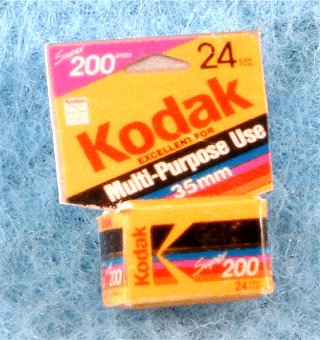Not too long ago I read a post by another blogger who had recently gotten a DSLR and asked for tips on taking great photos. While there were a lot of great tips, I had to cringe at the ones that said things like "just use automatic mode" and "turn your ISO up all the way and just leave it there." honestly, if you are going to invest the money to buy a DSLR, by all means, learn to use it to its full advantage!! you already know my thoughts on automatic mode, so this time we're going to talk about why turning your ISO up all the way is not always the right thing to do.
Long ago, we listed ISO as a way to control exposure but what is it? let's all think back to the days of film... do you remember buying it? it came in little boxes, like this.

see that "200" on there? that's the ISO rating. in the days of film, it indicated the sensitivity of the film to light. or how fast the film would record the light that hit it. these days, its referring to the sensitivity of the digital sensor, but the theory is the same.
ISO 100 is the least sensitive, or slowest to record. the light must continue to hit it for a long time before it is sufficiently exposed. therefore its useful in very bright light (like outdoors on a sunny day) when a faster film(or digital setting) would easily overexpose.
ISO 200 is slightly faster and is a good all-purpose outdoor setting.
ISO 400 is the standard indoor setting as it is more sensitive to light and exposes more quickly in situations with lower light. in a setting like this, if you had your camera set at ISO 100, you would require a much longer shutter speed and your picture would probably end up blurry due to camera shake.
ISO 800 and 1600 are faster still and are often used in indoor sports, when very fast shutter speeds are needed to freeze motion but the light is low so exposure is a concern.
So why don't you want to just leave your ISO cranked up so that you know you'll get enough light?? Much like shutter speed and aperture, ISO will also affect your photo, this time by causing grain. Grain is exactly what it sounds like... a grainy texture to the photograph. The higher your ISO is set, the more likely you are to run into grain.
Take the following two photos for example. (you will most likely need to click on them to see the large versions to really tell the difference).
this was shot in the bright sunlight at ISO 100.

this was shot at dusk using an ISO of 1600.

See if you can see a difference, especially in the darker areas. the top shot should look much smoother than the bottom.
Now don't get me wrong, grain is not always a bad thing. In fact, I quite like it in a lot of my photos. It kind of reminds me of black and whites from old issues of Life magazine. But if you are looking for a nice crisp, sharp photo grain doesn't usually help.
Leaving your ISO all the way up can also make your photos overexpose and its just not necessary. On a bright, sunny day with an ISO of 100 or 200, you are probably going to get shutter speeds faster than 1/125th or 1/250th. Unless your kid is going mach 3, that will be fast enough to prevent blur. the shutter speed of 1/3000th of a second is not going to look any different, and you may still overexpose if its bright enough.
TIP: if you are outdoors and you keep getting over exposed images, no matter how fast your shutter speed is, turn down your ISO (if this is the case, odds are your shutter speed will be blinking on your display. its your camera's way of saying "This is as fast as I go but its NOT GOING TO WORK")
TIP: if you are trying to take pictures indoors and you keep ending up with a long shutter speed that makes your pictures blurry, turn up the ISO
2 comments:
I think I just figured out why my totally awesome camera that I have no idea how to use sometimes blinks and blinks at me and acts like it's going to take a picture but just won't. Sigh. One of these days I'm going to sit down with your posts and take notes.
am I allowed to take benadryl?
ps...your photography posts make me very exctied to have you chronicle a month in the life of Baby Lahman. :)
Post a Comment